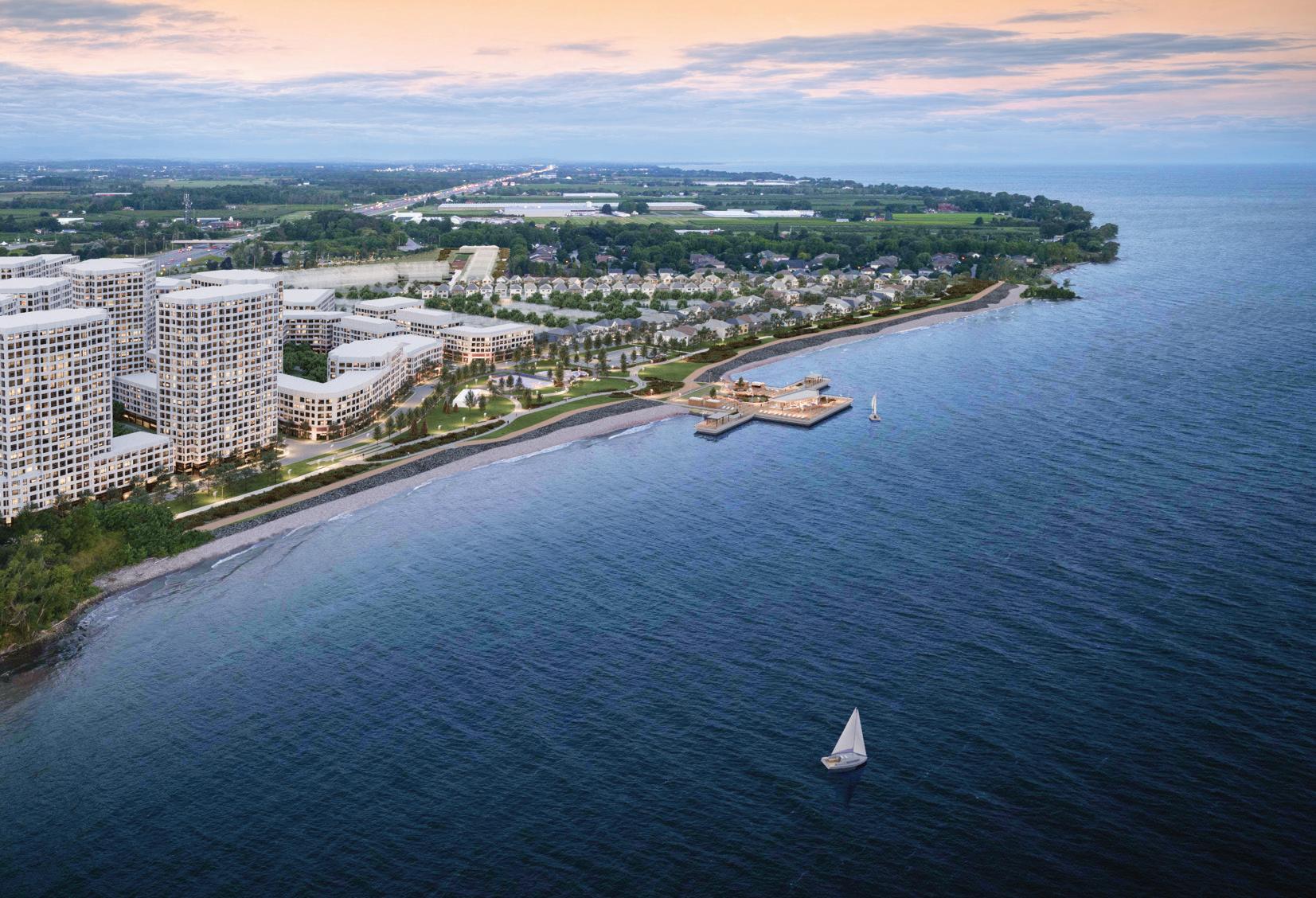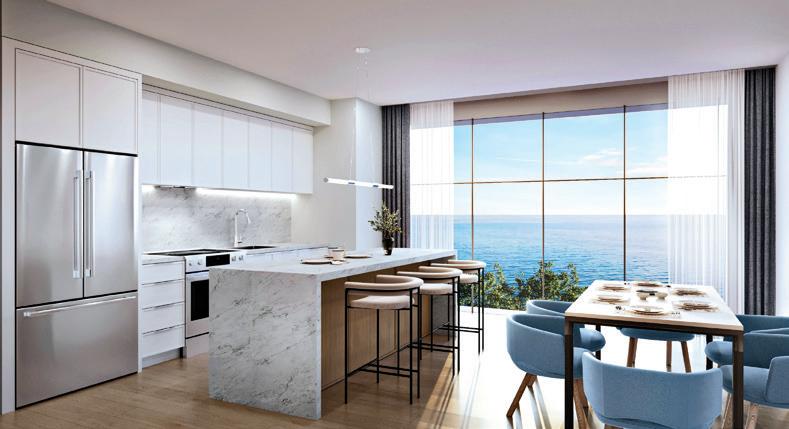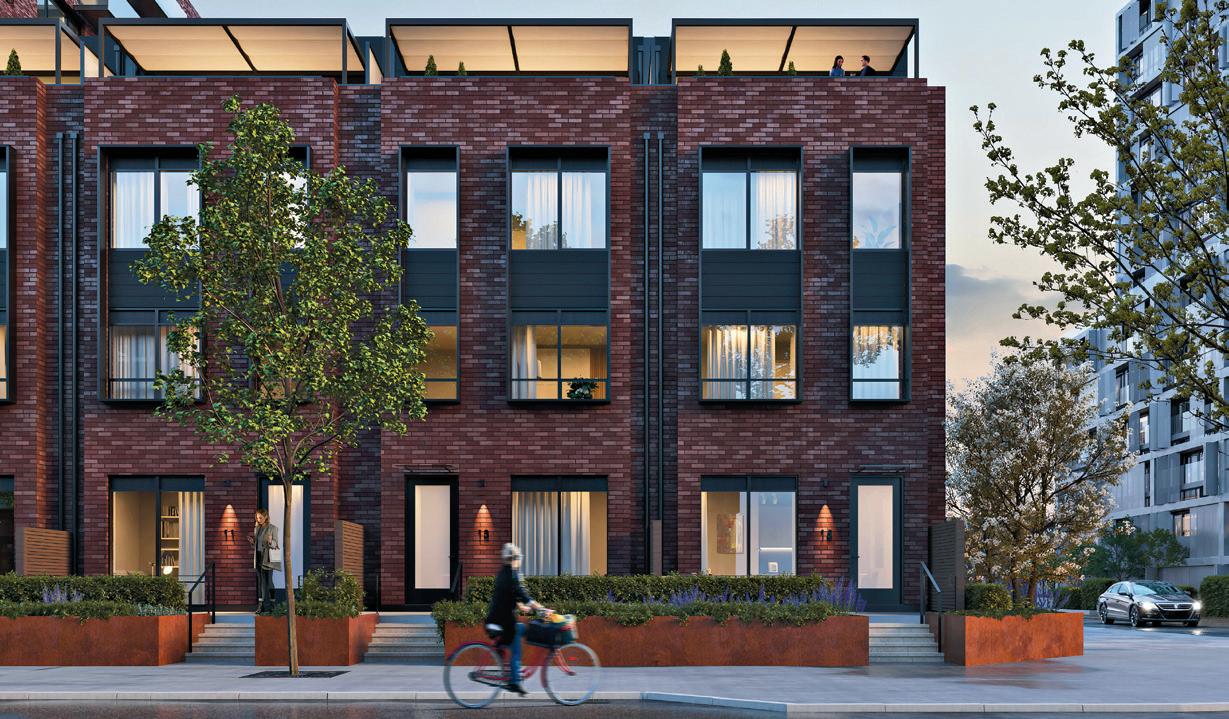




















Coming to the Shores of Lake Ontario in the Town of Lincoln
As a brand new master-planned community, Prudhomme’s Landing will reimagine the unforgettable legacy of family, community, and connection. Once Ontario’s most celebrated vacation destination, Prudhomme’s Landing will now become a place to experience lakeside living like never before. With thoughtfully-planned residences and amenities designed to engage and enrich every member of the community, it will soon become a village of its own—a place to live, work, play, and love.




WAYNE KARL
EDITOR-IN-CHIEF
Active Life Magazine
EMAIL: wayne.karl@nexthome.ca
TWITTER: @WayneKarl
You have to wonder sometimes how well governments actually pay attention. When it comes to housing, and the need to build more new homes in the Greater Toronto Area and elsewhere in Ontario, the answer to that question seems to be… not very much, or at least not closely.
Countless housing industry groups and other experts and observers, and even economists, have been sounding the alarm bells on the need for governments to address the growing affordability and supply challenges for years.
Indeed, in 2022, the Ontario government’s own Housing Affordability Task Force, comprising industry leaders and experts, consulted with stakeholders including municipalities and advocacy groups to ultimately produce a report with numerous recommendations.
Unfortunately, most of the recommendations have yet to be acted on or are “in progress.” Since then, uncertainty caused by U.S. tariffs, and other issues, have only exacerbated the situation.
Now, yet another group is raising the issue in a serious way.
The Large Urban Centre Alliance, representing homebuilders and rental providers from cities that account for more than 50 per cent of Canada’s annual housing starts, provided the federal government with a suite of recommendations to address the housing crisis. The recommendations to the pre-budget consultations for the government’s fall budget focus on the unique requirements of Canada’s major urban centres, such as the GTA. They are designed to support the federal government in achieving its bold housing goals while also protecting Canada’s economy from the growing risks posed by today’s unsustainable market conditions.
“Canada needs to double housing starts to address the current shortage, yet housing starts and sales are falling in some of Canada’s largest cities, as the cost of building homes makes homebuilding unviable,” says Dr. Mike Moffatt, Founding Director of the Missing Middle Initiative, and co facilitator of the Large Urban Centre Alliance. “The economic consequences are substantial; in the GTA alone, 41,000 jobs are at risk, along with over $6 billion in tax revenue per year. The federal government can address this crisis by taking actions to lower the cost of construction and removing the barriers to attracting investment in new housing.”
There are encouraging signs that the market is ramping up for a busy fall season (see news coverage and columns in this issue). And There’s mounting pressure for the Bank of Canada to implement a rate reduction on its next announcement on Sept. 17.
We need to keep the ball rolling. Now is the time to act.









An award-winning interior designer, Mariam Aboutaam is Director, Sales and Marketing, Interior Design at Kylemore, Markham, Ont., a builder known for master-planned communities and luxury homes. kylemoreliving.com.
Jesse Abrams is Co-Founder at Homewise, a mortgage advisory and brokerage firm based in Toronto. thinkhomewise.com
Mike Collins-Williams, RPP, MCIP, is CEO West End Home Builders’ Association. westendhba.ca.
Debbie Cosic is CEO and founder of In2ition Realty. She has overseen the sale of more than $15 billion worth of real estate. With Debbie at its helm, In2ition has become one of the fastest-growing and most innovative new home and condo sales companies. in2ition.ca
Mark Cullen is a Member of the Order of Canada, and provides gardening advice to more than two million Canadians each week. Ben Cullen’s specialty is food gardening. markcullen.com; Facebook @MarkCullenGardening and Pinterest @MarkCullenGardening.
Greg Gazin is a syndicated tech columnist, blogger, podcaster, and contributes to canoe.com, Troy Media and Active Life magazine. gadgetguy.ca
Barbara Lawlor is CEO of Baker Real Estate Inc. A member of the Baker team since 1993, she oversees the marketing and sales of new home and condominium developments in the GTA, Vancouver, Calgary and Montreal, and internationally in Shanghai. baker-re.com
Dave Wilkes is President and CEO of the Building Industry and Land Development Association (BILD), the voice of the homebuilding, land development and professional renovation industry in the GTA. For the latest industry news and new home data, follow BILD on Twitter, @bildgta or visit bildgta.ca.
SENIOR VICE-PRESIDENT, SALES, NEXTHOME
Hope McLarnon 416.708.7987 hope.mclarnon@nexthome.ca
SENIOR MEDIA CONSULTANT
Amanda Bell 416.830.2911 amanda.bell@nexthome.ca
EDITORIAL DIRECTOR
Amanda Pereira
EDITOR-IN-CHIEF – GREATER TORONTO AREA
Wayne Karl wayne.karl@nexthome.ca
CONTRIBUTORS
Mariam Aboutaam, Jesse Abrams, Mike Collins-Williams, Ben and Mark Cullen, Debbie Cosic, Greg Gazin, Barbara Lawlor, Dave Wilkes
EXECUTIVE MEDIA CONSULTANTS
Jacky Hill, Michael Rosset
VICE-PRESIDENT, MARKETING – GTA Leanne Speers
MANAGER CUSTOMER SALES/SERVICE
Marilyn Watling
SALES & MARKETING CO-ORDINATOR
Gary Chilvers
BUSINESS DEVELOPMENT MANAGER
Josh Rosset
DISTRIBUTION distributionteam@nexthome.ca
ACCOUNTING INQUIRIES
accountingteam@nexthome.ca
DIRECTOR OF PRINT MEDIA Lauren Reid–Sachs
VICE-PRESIDENT, PRODUCTION – GTA Lisa Kelly
PRODUCTION MANAGER – GTA Yvonne Poon
GRAPHIC DESIGNER & PRE-PRESS COORDINATOR Hannah Yarkony

Published by nexthome.ca
Advertising Call 1.866.532.2588 ext. 1 for rates and information. Fax: 1.888.861.5038
Circulation Highly targeted, free distribution network aimed at real estate buyers using street level boxes, racking and Toronto Star in-home delivery.
Canadian subscriptions 1 year = 6 issues – $35 (inc. HST). Canada Post – Canadian Publications Mail Sales Product Agreement 40065416.
Copyright 2025 All rights reserved. All copyright and other intellectual property rights in the contents hereof are the property of NextHome, and not that of the individual client. The customer has purchased the right of reproduction in NextHome and does not have the right to reproduce the ad or photo in any other place or publication without the previous written consent of NextHome.
Editorial Submissions from interested parties will be considered. Please submit to the editor at editorial@nexthome.ca.
Terms and Indemnification Advertisers and contributors: NextHome is not responsible for typographical errors, mistakes, or misprints. By approving your content and/ or submitting content for circulation, advertisers and contributors agree to indemnify and hold harmless NextHome and its parent company from any claims, liabilities, losses, and expenses (including legal fees) arising out of or in connection with the content provided, including but not limited to any claims of copyright infringement, unauthorized reproduction, or inaccuracies in the content. Advertisers acknowledge that they have the necessary rights, permissions, and licenses to provide the content for circulation, and they bear full responsibility for the content’s accuracy, legality, and compliance with applicable laws upon approval. Contributors acknowledge NextHome reserves the right to omit and modify their submissions at the publisher’s discretion.


The Greater Toronto Area (GTA) experienced the best home sales result for the month of July since 2021, according to the latest statistics from the Toronto Regional Real Estate Board (TRREB). Sales were also up relative to listings, suggesting a modest tightening in the market compared to last year.
“Improved affordability, brought about by lower home prices and borrowing costs, is starting to translate into increased home sales,” says TRREB President Elechia BarrySproule. “More relief is required, particularly where borrowing costs are concerned, but it’s clear that a growing number of households are finding affordable options for homeownership.”
GTA realtors reported 6,100 home sales through TRREB’s MLS System in July 2025 – up by 10.9 per cent compared to July 2024. New listings totalled 17,613 – up by 5.7 per cent year-over-year.
On a seasonally adjusted basis, July home sales increased month-overmonth compared to June 2025. New listings also rose compared to June, but by a much lesser rate. With sales increasing relative to listings, market conditions tightened.
The MLS Home Price Index Composite benchmark fell by 5.4 per cent year-over-year in July 2025. The average selling price, at $1.05 million, was down by 5.5 per cent compared to July 2024. On a month-over-month seasonally adjusted basis, the MLS HPI Composite and average selling price remained flat compared to June.
“Recent data suggest that the Canadian economy is treading water in the face of trade uncertainty with the United States,” says TRREB Chief Information Officer Jason Mercer. “A key way to mitigate the impact of trade uncertainty is to promote growth in the domestic economy. The housing sector can be a catalyst for growth, with most
spin-off expenditures accruing to regional economies. Further interest rate cuts would spur home sales and see more spin-off expenditures, positively impacting the economy and job growth.”
“Despite widespread belief that the federal foreign buyer ban prohibits all foreign nationals from purchasing residential properties in Canada, there are exemptions that allow nonresidents to buy property, resulting in spin-off benefits to the economy,” adds TRREB CEO John DiMichele. “Foreign buyers can purchase multiunit buildings with four or more units and vacant land or land for development. Non-residents can also buy other residential properties outside urban centres, including recreational properties.
“Moreover, temporary workers and international students can purchase residential property under defined circumstances under the ban extended until January 2027,” he says.
The Residential Construction Council of Ontario (RESCON) and several industry representatives recently hosted federal Housing and Infrastructure Minister Gregor Robertson and Canada’s Secretary of State for Labour John Zerucelli, to discuss challenges facing the industry.
The group toured the H+ME Technology Plant in Etobicoke, and later the minister and secretary of state met with the group to discuss the challenges facing Ontario’s residential construction sector and the potential effects on the economy. The group also had a wide-ranging conversation about initiatives that need to be put in place to spur new residential building.
Attendees discussed the need to accelerate both PropTech and ConTech, as well as the state of offsite construction and what can be done to accelerate growth and increase production and delivery of housing. RESCON says it appreciates that Robertson and Zerucelli took time out to meet and look forward to working with the federal government to spur construction of more housing.

“Immediate bold and concerted action is needed to get more shovels in the ground for housing projects,” says RESCON President Richard Lyall. “The residential construction industry is in dire straits, and new housing starts and

sales are grim. We need to lower development charges, reduce red tape which only adds to approval timelines, and speed up the approvals process. Without a healthy residential construction industry our economy will suffer.”
The association warns that a decline in residential construction has the potential to devastate Ontario’s economy. A 30-percent drop in industry activity, for example, could result in 121,500 total job losses; a 50-per-cent drop would result in 202,500, and an 80-per-cent dip would total 324,000.
“The entire economy of Ontario would feel the effects of such an industry employment decline,” says Lyall. “Industries that supply the new home market with everything from lumber to drywall and windows would also be affected. A decline in the construction workforce would result in hardship for many families. It is critical that we take swift action to boost homebuilding in Ontario.”


GREG GAZIN

Air quality in our homes not only affects our well-being, but also the quality of our much-needed sleep. While good housekeeping habits can help, so can an air purifier. But not all home air purifiers are created equal. Few are designed like the IQAir Atem Desk Air Purifier, which helps keep us from breathing in those nasty, often invisible ultrafine particles that can potentially wreak havoc on our health.
We’re constantly exposed to microscopic particles in the air – from visible dust and pollen to invisible threats such as wildfire smoke, viruses and combustion fumes. The
smaller the particles, the deeper they can travel into our lungs – and the more dangerous they become. (See sidebar).
That’s why choosing the right kind of air filtration matters. Most popular purifiers use True HEPA filters, which are great at capturing many fine particles out 99.97 per cent of fine particles down to 0.3 µm – but they often miss the smallest ones: Ultrafine particles (UFPs).
This is where the Swiss-designed, German-made IQAir Atem Desk Air Purifier really stands out. It features a Smart HyperHEPA filtration system that captures up to 99.5 per cent of particles down to 0.003 µm –that’s 100 times smaller than what traditional HEPA filters target. This includes those microscopic virus particles.
It’s a personal purifier, designed to sit on your desk or nightstand and clean the air immediately around you – up to about 150 sq. ft. It’s ideal for a bedroom, small office or nursery, and highly efficient thanks to its focused PureJet diffuser.
It’s also whisper quiet – only 20 dB at the lowest fan setting (about the sound of rustling leaves) and just 44 dB at the highest, no louder than a quiet fridge. While that might seem impossible given its performance, it’s all thanks to IQAir’s clever, patented industrial design.
The system isolates vibration from the fan and motor, preventing it from transferring to the outer shell. That means no buzzing or rattling – just smooth, stable operation. It also redirects sound back into the unit, acting like built-in soundproofing,
reducing the amount of noise that escapes into your space. The result? Clean air with barely a sound.
Beyond function, it’s stylish, too. Imagine if Apple designed an air purifier – that’s the IQAir Atem Desk. They didn’t, but at first glance, it looks more like a premium Apple accessory than a traditional air purifier. Its sleek, circular design, minimalist stand and near-invisible interface wouldn’t look out of place beside a MacBook Pro or a Bondi Blue iMac G3.
In fact, I couldn’t help but imagine Jony Ive at a live Apple event narrating: “We wanted to purify the air... but in a way that was quiet, intentional and beautifully uncompromising.” The design is clean, focused and elevates desktop purification to something almost sculptural.
It looks like a flying saucer on a stand, and while it’s not backpack-sized, it’s portable. It measures 12.4-by-5.5by-11.8 in. and weighs slightly more than six lbs – small enough for a suitcase.
With the optional Car Accessory Kit, you can convert the Atem Desk for in-car use. The kit includes a mount, belt and power adapter, allowing you to securely attach it to a car seat for HyperHEPA filtration on the road.
Setup is simple: Clip on the base, plug it in and tap the centre panel to choose one of three speeds.
For added control, connect it via Bluetooth and download the IQAir Atem app. The app lets you adjust fan speed, monitor filter life and customize smart settings such as auto on/off and environment-based triggers.
Changing the filter is a breeze – just remove the back cover. The unique 270-degree filter design ensures thorough coverage and efficient airflow.
If you’re serious about air quality – especially when it comes to the tiniest airborne threats such as viruses and UFPs – the IQAir Atem Desk HyperHEPA Air Purifier is a powerful and stylish solution.
It’s perfect for smaller, personal spaces. Just note: It’s not designed to clean a large living room or be knocked around. Place it thoughtfully, and it performs like a champ.
At home, on the go, or even in the car, it’s a worthwhile investment if you want cleaner air without a bulky machine.
Price: $576.99. It comes with a three-year limited warranty and is available on Amazon and on-line at Walmart, and Best Buy, or at iqair.com.

Particulate matter is measured in microns. A micron (µm) is 0.001 mm or one micrometre. For perspective, a single human hair is about 60 µm wide.
• PM10 (Coarse Particles): 2.5–10 µm
Examples: Pollen, mold spores, dust, pet dander
• PM2.5 (Fine Particles): < 2.5 µm
Examples: Smoke, bacteria, cooking aerosols, emissions from stoves or fireplaces
• PM0.1 (Ultrafine Particles / UFPs): < 0.1 µm
Examples: Viruses (COVID-19, flu), industrial exhaust, laser printer dust, combustion particles
According to the U.S. EPA, many scientific studies have found that breathing even fine particulate matter (PM2.5) over the long term can lead to various health effects, including damage to blood vessels and the heart.

Greg Gazin is a syndicated tech columnist, blogger, podcaster, and contributes to canoe.com, Troy Media and Active Life magazine. gadgetguy.ca
+MORE CONTENT ONLINE nexthome.ca

If you haven’t been to Collingwood lately, you’re missing out. Blessed with a beautiful natural location at the southern point of Georgian Bay, just 160 kms north of Toronto, it has long been a popular destination for winter skiing and summertime golf, cycling and festivals.
But an important transition is unfolding in this town of about 22,000, taking one of Ontario’s most prominent shipbuilding communities and vacation destinations into a four-seasons paradise, replete with elevated homeowning and lifestyle opportunities.
Chief among them is Collingwood Quay, a six-storey, 100-suite boutique condominium from FRAM + Slokker. Ideally located on Collingwood’s waterfront at the head of Hurontario Street, residents are within sandal steps of spectacular walking and biking trails, a ski-pole’s length from the ski hills at the Blue Mountains and a breeze to picturesque downtown.
If you’ve ever dreamed about waterfront living surrounded by nature, now’s your chance, at Collingwood Quay.
The final phase of FRAM + Slokker’s Collingwood Shipyards masterplanned community development in downtown Collingwood, the project was recently released for sale after many months of research, including surveys and focus groups with potential buyers.
One of the most unique features of Collingwood Quay is that, since it’s surrounded by water on three sides, every single suite has a view of Collingwood Harbour. It is also located at the end of Main Street, making retail, shopping and attractions all just steps away.
Buyers “appreciate that Collingwood is a four-seasons town with lots of things to do year around, and yet less than two hours from the GTA,” says Fred Serrafero, senior vicepresident at FRAM + Slokker. “Buyers
love the intimate setting, overlooking the water and walking distance to everything they need.”
Designed by award-winning architect Giannone Petricone Architects – and the only new waterfront condo in town – luxury and proximity are central to Collingwood Quay. Suites range from 870 to more than 2,100 sq. ft.– with the ability to combine two suites, if buyers so desire. Eighty-five per cent of suites are either two-bedroom or two-bedroom plus den, with the remainder one-bedroom plus den.
Prices range from $790,000 to $3.1 million, and all suites include a parking space and locker. Larger suites come with two parking spaces. To connect with – indeed immerse in – the natural surroundings, all balconies are designed as all-seasons spaces using a Lumon retractable glazing system, designed in Finland and built in Vaughan. On warm, summer days, slide the glass open

and feel the sun shimmer down while enjoying the sounds and ambience unique to your waterside address. During wind, rain and cooler temperatures, slide the glass shut to continue enjoying bright, unobstructed views of the harbour.
For further relaxation, most bathroom sare complemented with an oversized shower and standalone soaker tub.
Add to all this, a party room and private dining space, an exclusive terrace with lounge and barbecue area, a gym and yoga studio, pet spa and storage for bikes, skis and other outdoor toys… and you have all the retreats and spaces for personal enrichment you could want.
When it comes to transformational waterfront projects, FRAM + Slokker knows what of it speaks.
As the final phase in the company’s Shipyards master-planned community, Collingwood Quay will further help breathe new life into the town’s waterfront, augmenting the Shipyards’ collection of townhomes, plus a new waterfront park with seasonal boat docking, an open-air amphitheatre and multi-purpose trails connecting the community to the mountains and water.
“Our waterfront experience dates back to our Port Credit Village development starting in 1998,” Serrafero says. “It kind of put us ‘on the map,’ sort to speak,

notwithstanding that we had been developing residential properties across the GTA since the early 1980s.”
Since then, in addition to the Collingwood Shipyards, FRAM + Slokker has built the East Village riverfront community in downtown Calgary, Brightwater in the Port Credit area of Mississauga, and more recently Orillia.
“Our projects are quite unique, as we take great pride in consulting with the community before we put pen to paper. We also do a lot of work understanding who our buyers are and what they want. Add to that a flair for great architecture and a passion for sustainability, and you’ve got our recipe.”
Bringing this approach to Collingwood feels like a natural progression. Luxurious boutique condo living… all-seasons activities literally at your doorstep… modern amenities at your fingertips… that’s not just a recipe for the next wave of waterfront condo living, it’s an actual formula.
With construction set to begin some time next year and to be completed in 2028, now is the perfect time to begin the life you’ve always dreamed of.
For more information or to register, visit collingwoodquaycondos.com, or visit the presentation centre at 10 Side Launch Way in Collingwood.

Let’s face it: Today’s new-home buyers are looking for enhanced affordability and a quicker turnaround to take possession of their new digs. After years of new-home builders and developers asking government to intervene in the bureaucracy that has held up new home building
unnecessarily, the Province of Ontario has introduced Bill 17 (Protect Ontario by Building Faster and Smarter Act, 2025). The aim of this Bill is to standardize, simplify and streamline development processes to fast-track infrastructure (such as transit, roads and water systems) and new home

and condominium communities. It is also designed to cut down on the exorbitant development charges that can add up to 35 per cent onto the price of new homes.
We need to add more than two million homes over the next decade to accommodate increasing demand, so this government action is welcome by both consumers and the industry. Cutting down on the time it takes to get municipal approvals means builders can deliver homes more quickly and at more affordable prices.
Contrary to what you might think, the Bill does not require the province to build homes, but rather to partner with municipalities to
create conditions that will help builders and developers construct the needed infrastructure and homes more efficiently. Currently, most bottlenecks preventing the best outcome for efficiency happen at the municipal level.
With that in mind, among the Bill’s measures are:
• Standardization of Ontario Building Code across the province to work toward eliminating much red tape, thus bringing homes and condos to market faster
• Working with municipalities to streamline permits and approvals to reduce costs and expedite projects, particularly around transit corridors

• Enabling fewer studies by municipalities, again eliminating red tape
• Standardizing Official Plans across the province so approvals can be achieved more efficiently. (In most cases, these timelines involve the builder/developer submitting detailed plans to the appropriate municipalities, as well as city staff reviews, public consultation meetings, and a council vote – all of which can take up to two years and more, which results in home prices rising yet again)
• Accelerating the building of infrastructure such as roads, transit and water systems
The Bill has a lot of support from homebuilder associations at all levels, and the municipalities of Mississauga and Vaughan have already taken steps to drastically reduce development charges on new houses and condominiums.
On the federal level, we would like to see the recent GST reduction for first-time buyers expanded to include everyone purchasing a new home or condominium. In addition, we prefer that the ban on foreign investment in real estate be lifted. We need investment here in Canada, as most major cities in the world are built on investor money.
The bottom line is that we need change now to prevent more people leaving Ontario because of the lack of affordability and supply when it comes to housing. Bill 17 may not be a magic bullet, but it is a definite step in the right direction that will benefit us all.
Barbara Lawlor is CEO of Baker Real Estate Inc. A member of the Baker team since 1993, she oversees the marketing and sales of new home and condominium developments in the GTA, Vancouver, Calgary and Montreal, and internationally in Shanghai. baker-re.com
+MORE CONTENT ONLINE nexthome.ca

JESSE ABRAMS

In today’s market, many Canadian homebuyers are caught between two conflicting thoughts: Should I wait for
interest rates to drop, or is now the right time to buy?
The Bank of Canada has hinted that rate cuts could continue through the rest of 2025. That sounds promising, but the real question is whether waiting for a better rate is actually better for your financial future. The answer isn’t
always straightforward and depends on a few key factors.
THE RISKS OF WAITING
Yes, rates might go down, but home prices can go up. If you wait for rates to fall, more buyers may jump into the market again, pushing up prices and reviving bidding wars. A lower rate

doesn’t always lead to lower monthly payments if the price of the home you buy is significantly higher.
You also need to consider that waiting too long might mean missing out on properties that suit your needs and budget. The perfect home could come and go while you’re holding out.
“ ” If you’re financially ready and have found a home that suits your needs, now could be a strategic time to buy.

We’re in a rare moment with higher inventory and more motivated sellers. That means more negotiating power, price flexibility and time to make the right decision. Buyers are in a stronger position to avoid overpaying or rushing into a bidding war.
Plus, if rates do drop significantly in the future, you can consider refinancing. You aren’t locked into the rate you get today forever. In fact, many Homewise clients are able to refinance to a lower rate when the time is right, thanks to lender features like early renewal windows or refinancing options without large penalties.
If you’re financially ready and have found a home that suits your needs, now could be a strategic time to buy. With a mortgage pre-approval, you can lock in today’s rate for up to 120 days while you shop. That gives you peace of mind and flexibility.
You also reduce the stress of rising prices or surprise interest rate changes during your home search. And with Homewise, we help clients find the best rate and features across more than 30 lenders in Canada, which makes the process simpler and more rewarding.
Trying to time the market perfectly is nearly impossible. If you’re financially ready, have a long-term outlook, and find a property that checks your boxes, it’s worth taking the next step. Talk to an expert, get pre-approved and approach the market with clarity and confidence.
Jesse Abrams is Co-Founder at Homewise, a mortgage advisory and brokerage firm. thinkhomewise.com
+MORE CONTENT ONLINE nexthome.ca
DEBBIE COSIC

The past few years have brought more change to the pre-construction real estate market than most of us have seen in decades. For many buyers, the market we once knew –fast-moving, equity-rich and full of short-term wins – feels like a distant memory. But in reality, we’re not in a “dead market.” We’re in a transformed one. And that transformation demands a new kind of buyer.
At In2ition, we’re calling this moment the re-education of the preconstruction buyer.
Gone are the days when buying was driven by fear of missing out
“ ” We’ve had the market reset. Now it’s time for the mindset reset.
and hype. Today’s environment demands clarity, data and patience. The buyers who will thrive going forward are the ones who understand that real estate, especially pre-construction, is a long game.
Yes, interest rates remain high. Yes, launches have slowed. But the fundamentals of our market haven’t disappeared, they’ve just quieted down. Population growth hasn’t

stopped. And housing demand hasn’t disappeared. What’s changed is how buyers need to approach the game. We’re seeing more investors and end-users alike asking better questions: What’s the builder’s track record? How solid is their financing? What’s the realistic timeline here? That’s a good thing. Cautious, wellinformed buyers create a more stable and sustainable market for everyone.

At In2ition, we’re spending more time than ever guiding our builder clients through these conversations, not just selling product. Education, transparency and smart decisionmaking are our priorities right now, because those are the qualities that build long-term wealth.
If you’re a buyer waiting on the sidelines, that’s okay, but don’t wait passively. Use this time to educate yourself. Know what kind of investor
you want to be. Get pre-approved. Understand the numbers. Watch the builders that are still moving forward – because those are often the ones that know exactly what they’re doing.
This market won’t stay frozen forever. When it shifts, and it will, the buyers who took the time to sharpen their tools today will be the first to act and the first to benefit.
We’ve had the market reset. Now it’s time for the mindset reset.
Debbie Cosic is CEO and founder of In2ition Realty. She has overseen the sale of more than $15 billion worth of real estate. With Debbie at its helm, In2ition has become one of the fastest-growing and most innovative new home and condo sales companies. in2ition.ca
+MORE CONTENT ONLINE nexthome.ca


This is our favourite time of year for only one reason – the roses. What would we do without them? What isn’t there to love about them? Their timeless beauty is proof of their popularity. They fill your garden with perfume and from bud to bloom they delight us whether clambering over trellis, an old brick wall, lighting up the flower bed or simply covering the ground.
If you are new to roses, you may think that they require chemicals to control the insects and diseases that bug them.
We are here to report that it is possible to grow beautiful roses chemical-free. Mark has been growing roses in his garden for 35 years without the use of pesticides. He has more than 25 roses in his collection and he does not spray any of them.
1. Buy roses that are naturally “disease and insect resistant.” These words, when written on the tag of a Canadian-grown rose, are golden.
A rose variety that carries on with its business of flowering and attracting butterflies and songbirds to your garden without surrendering to black spot, powdery mildew and aphids (to name a few of the potential enemies of the rose grower) is a winner in anyone’s books.
2. Change your habits. Sometimes the “problems” with roses are the result of things that we do to grow them. Black spot and powdery mildew? Water only at the bottom of the plant, avoid wetting the foliage, water in the morning so that the sun burns off surface moisture and by above all allow the soil to get

dry between waterings about five cm down. This is most important of all. When you do water them, do so thoroughly
3. If you have a persistent problem with insects or disease on your roses, use an all-natural solution. Diseases? Use garden sulphur or Bordo mixture for control.
Insect problems? You will be surprised at how many of them can be dealt with nicely using insecticidal soap. Or, just ignore them and let the birds and carnivorous insects such as praying mantis devour them.
We have been hearing from the organic producers of apples, tomatoes, and all manner of edibles that we need to look at the fresh food that we consume a bit differently: To accept that not everything fit to eat looks like a perfect picture. We suggest that the same is true for flowering plants as well, including roses.
Changing our standards is one other solution to insect and disease damaged roses. The perfect, blemishfree rose may not be the only rose worthy of our attention. We have seen some fine flowers born on thorny stems with some black spot on the leaves.

Give aphids a stiff blast of water from the end of the hose to rid your garden of them.
Remember to add at least two in. (five cm) of shredded bark mulch this time of year, which helps deter weeds and retain soil moisture.
As the season progresses, you will want to keep your roses blooming for as long as possible. When the flowers fade, the rose will set seed which slows the production of new flowering shoots. Remove these blooms to fool the plant into producing more flowers. This process is called deadheading. This form of summer pruning involves

removing the finished bloom at the abscission layer, which is the slightly swollen section of the stem below the bloom. In the past, it was the practice to remove the bloom far lower down the stem, but it has now been proven that retaining maximum foliage on a rose promotes a better performance and appreciably more flowers.
If you think that the best show in the rose garden is long gone, you might be surprised. The June performance was spectacular, but the September show can be just as good. The shorter days and cooler temperatures of late summer and early fall suit roses well. Especially if you “deadheaded” yours last spring.
Mark Cullen is a Member of the Order of Canada. He is the Chair of Canadian Trees for Life, a charity dedicated to planting trees in the urban environment to honour our health care workers, first responders and military, one community at a time. treesforlife.ca. Ben Cullen is a professional gardener with a keen interest in food gardening and the environment. He is the founder of Cullen’s Foods, now a part of Yorkshire Valley Farms. You can follow both Mark and Ben on Twitter @MarkCullen4, Facebook @MarkCullenGardening and Instagram @MarkCullenGardening. Sign up for their free monthly newsletter at markcullen.com.
+MORE CONTENT ONLINE nexthome.ca
MIKE COLLINS-WILLIAMS

If you’re feeling uneasy about having or taking on a mortgage right now, you’re not alone. We haven’t seen a market dip like this since the early 1990s. But here’s the good news: Downturns don’t last forever, and the rebound always comes.
The real estate market, like all markets, moves in cycles. What rises must eventually fall. But it is important to remember that what falls will rise again. For homeowners, investors and industry professionals navigating the current downturn, this truth can offer reassurance and perspective. Downturns are temporary and recovery is part of the cycle.
It’s understandable to feel uneasy during a market slowdown. Your property value may have dipped. According to Urbanation, “The Greater Toronto Hamilton Area (GTHA) new condominium apartment market produced 502 sales in Q2-2025… activity this year was 91 percent below the 10-year average.” These numbers are striking, but they’re not unprecedented. Real estate has always rebounded, and often with renewed strength. Whether driven by interest rate shifts, inflation or economic tightening, every downturn in recent history has eventually given way to renewed growth.
Look back to 2008, one of the most dramatic real estate downturns in modern memory. Confidence was

shaken. In Canada, home purchases declined about 40 per cent and housing starts fell. Yet within two years, the market began a strong and sustained recovery. By the mid-2010s, markets picked up and, in many cases, soared to record highs. Those who held on or invested wisely during the low were often those who saw the greatest rewards in the rebound.
Real estate is fundamentally tied to the human need for shelter, community and stability. While markets may cool, the underlying value of real estate as a long-term asset remains resilient. For many, downturns offer unique opportunities. For buyers, it may be a chance to enter the market at lower prices and expanded choice. For homeowners, it’s a time to focus on the long-term benefits of ownership – stability,
equity growth and a place to call your own. And for investors, the current market may be the fertile ground from which future gains are made.
Patience is key. Purchasing a home is not about quick wins. It’s a marathon, rather than a sprint. Trust in the history of cycles, in the strength of the market to recover, the value of what you own and the advantages of purchasing in a downturn.
Hold steady. The market will rise again. It always does.
Mike Collins-Williams, RPP, MCIP, is CEO West End Home Builders’ Association. westendhba.ca.

As many of us approach the golden years of retirement or consider the next stage of life, the place we call home becomes more important than ever. It’s not just about square footage or curb appeal, it’s about lifestyle, comfort, community and making a smart investment in our future.
That’s where Sinclair Homes is leading the way.
A family-owned builder rooted in the Kitchener-Waterloo Region, Sinclair Homes is rewriting what it means to “live-well” and “age well.” Its mission goes beyond bricks and mortar; the company is committed to crafting homes and communities that support active, fulfilling lifestyle for today’s homeowners who are planning for tomorrow.
Whether you’re dreaming of waterfront living in Meaford at South Georgian Bay, the charm of country modern lifestyle near Lake Erie in Simcoe or the vibrant countryside of rolling green hills near Woodstock in Embro, Sinclair Homes is building in some of the most desirable, walkable and nature-connected locations in Southern Ontario. These aren’t just developments, they’re thriving communities that offer easy access to highways, shopping, quick access to
hospitals and schools, trails, beaches, golf and small-town culture, while staying within reach of major amenities.
But what truly sets Sinclair Homes apart is its unwavering commitment to quality and sustainability. Every home it builds is fully Net Zero; meaning the home produces as much energy as it consumes over the course of a year. These homes aren’t just better for the environment, they’re better for your wallet and your well-being. With advanced insulation, triple-pane windows, highefficiency HVAC systems and solar panel integration, Sinclair homes are designed to minimize energy bills, reduce maintenance headaches and provide year-round comfort.
You’ll also notice that Sinclair Homes includes the kinds of features many other builders call “upgrades.” Quartz countertops, stainless steel energy-efficient appliances, luxury flooring, patios or decks, designer lighting packages, and smart home integrations – all included as standard.
Each home is thoughtfully laid out with wide hallways, spacious bedroom and open-concept living spaces ideal for entertaining family or simply enjoying the quiet moments.
And while many builders talk about sustainability, Sinclair lives it. The company is the first and among the few in Ontario exclusively building to Net Zero standards, which is a rare and bold commitment in today’s market.
It’s a forward-thinking promise to homeowners: Your Sinclair home is future-proof, healthier to live in and built to last.
As more of us downsize, simplify or look to invest in communities that reflect our values, Sinclair Homes offers something rare in the marketplace: Trust.
You can see it in the craftsmanship, feel it in the quality of the materials and believe it when they say they’re building for a better tomorrow, for our generation and the next.
When you choose Sinclair, you’re not just buying a home. You’re choosing peace of mind, environmental leadership and a legacy of living – and aging-well. Explore the bungalow townhome model home at 2 Painted Skimmer Pl. in Simcoe and discover more.
For more information, call 226.476.2227.

by MARIAM ABOUTAAM
AS A DESIGN FOUNDATION, NOT JUST A FINISHING TOUCH
A sculptural glass chandelier for the living room became the centrepiece of our vision


At Kylemore, lighting is never an afterthought, it’s among the first things we plan when designing our model homes. Before drywall is installed or any millwork is produced, we create an electrical plan that addresses both practical and decorative needs for every room. While decorative lighting elements are introduced later in the design process, their placement and purpose are accounted for from the beginning.
We review each room, considering how lighting will function, enhance atmosphere and contribute to the overall aesthetic. In pre-construction, homebuyers are typically offered a standard electrical package, but many Kylemore buyers opt to upgrade, adding more pot lights, dimmers or electrical rough-ins for future chandeliers, wall sconces and pendant fixtures. These upgrades allow for personal expression and future flexibility.
Tip: If you’ve already purchased or selected a light fixture for a specific room in your home, be sure to discuss it with your builder’s design

consultant. They can determine whether the fixture requires additional structural support; something that should be installed before the drywall goes up.
Lighting becomes integral to our design mood boards, where materials such as metal, fabric, glass and even stone are selected to complement cabinetry, furnishings and wall finishes. In one recent model home, a sculptural glass chandelier for the living room became the centrepiece of our vision. Despite a delayed delivery, we waited for the light we chose to arrive as we believed it was irreplaceable and vital to the design.
Each room presents an opportunity to elevate the experience through lighting. In open concept living and dining areas, a dramatic fixture can unify the space. Dining rooms invite bold statements, for example, long fixtures that span the entire table and command attention. Powder rooms, too, offer a chance to play with finishes, introducing luxurious touches through striking sconces or unique materials like marble. Artwork, when lit from above, can transform the mood of the room it’s featured in.
Bedrooms call for a softer approach. We lean toward dimmable
fixtures that promote rest and relaxation. In bathrooms, we often light vanities with fixtures that provide both function and flair.
Sometimes, a light fixture becomes the final piece that completes a room. When designing a model home, I carry a snapshot of the entire space around in my head, so when I’m shopping for finishing touches, I’m always on the lookout for that perfect item. Whether it’s a floral-inspired pendant over the kitchen island or nature-influenced sconces in the powder room, these details communicate craftsmanship and creativity. Often, they’re happy accidental finds discovered during sourcing, that instantly feel like they were meant to be part of the design, bringing the room to life.
Lighting does more than illuminate; it shapes how a home feels and functions. At Kylemore, we treat it as an essential element that ties every design detail together while allowing homeowners to express their personal style.
In my next column, I’ll be sharing how we approach space planning in model home design.
An award-winning in-house designer, Mariam Aboutaam is Director, Sales and Marketing, Interior Design at Kylemore, Markham, Ont., a builder known for masterplanned communities and luxury homes. kylemoreliving.com.
P o r t P e r
NOTE: SINCE MAP LOCATIONS CANNOT BE MORE PRECISE, IT IS ADVISABLE TO PHONE AHEAD FOR SPECIFIC DIRECTIONS.
NOTE: SINCE MAP LOCATIONS CANNOT BE MORE PRECISE, IT IS ADVISABLE TO PHONE AHEAD FOR SPECIFIC DIRECTIONS.
Ashgrove Meadows, Picture Homes – 905.985.0808
The Davis Residences, LCL Builds/Rose
Juniper Gate, Remington – remingtonhomes.ca
OakPark, Ballantry Homes – ballantryhomes.com
Parkland on Eglinton West, Shannex – 416.997.2647
Parkland on the Glen, Shannex – 905.820.8210
St. David’s Village – 416.267.2737
Seasons Clarington – 905.697.9992
Seasons Milton – 905.864.6888
Tapestry at village Gate West – 416.777.2911
Wellings of Whitby, Nautical Lands – 905-243-1386
Allora Condos, Urbandale – 613.822.2190
Aura By The Lake, Kaitlin Corp. – kaitlincorp.com
Blue Bay villas at Cobble Beach & Georgian Villas Custom Homes – 1.877.781.0149
Lookout, Allan Dev./valour – bluepointlookout.com
RiverBend Golf Community, Sifton Properties – 519.657.4333
The Village Farm – sinclairhomes.ca
GOLDEN HORSESHOE
Argyle, Reid’s Heritage – argylevillage.ca
Bench Mark, Losani Homes – losanihomes.com
The Block on Clair, Reid’s Heritage– blockonclair.ca
Century Condos, Homes By DeSantis centurycondos.ca
Grimsby Waterfront, Losani – losanihomes.com
Harbourtown Village, Silvergate – harbourtownvillage.ca
Lackner Ridge, Reid’s Heritage – lacknerridgetowns.ca
Maplewood, Losani – losanihomes.ca
Modal at Main, Reid’s Heritage – modalatmain.ca
The Oaks at Six Mile Creek, Blythwood Homes Townhomes at the Oaks in Ridgeway – blythwoodhomes.ca
Prudhomme’s Landing – prudhommeslanding.com
Soho, Losani – losanihomes.ca
St. Elizabeth Mills, Zest – 905.574.8178
Watercrest at Hunter’s Point, Luccetta – luccettahomes.com/watercrest
Wellings of Waterford – 1.800.996.9885
COTTAGE COUNTRY
Royalton Homes – aquavil.ca
Ashton Meadows, Briarwood – ashtonmeadows.ca
Baybourds – sinclairhomes.ca
6, Pratt Homes – 705-733-0300
Braestone Horseshoe Valley, Georgian international – 705.727.5656
Collingwood Quay – collingwoodquaycondos.com
Sands, Elm Dev. – georgiansands.com

If you’re thinking about renovating your home this fall, the time to start planning is now. Renovations aren’t something you can rush – from design ideas and budgeting to permits and contractor selection, each stage requires thoughtful preparation to be done right. Starting early allows you to explore your options, develop your vision avoid delays down the road and create a realistic timeline that supports your desired outcome. Whether you are thinking about a more functional kitchen, updating outdated bathrooms or finally tackling that underused basement, a wellplanned approach will help ensure a smoother renovation experience. Begin by determining what your goals are for the renovation and create a description of what you would like to change. Decide what aspects on your wish list are realistic in terms of your budget and timeline and doable in terms of building and space available. Create a complete picture of what is needed by involving everyone in your household. Keep in mind, there are a variety of apps designed to create checklists, develop images and basic floorplans. These are in no way a replacement for professional drawing and designs, but they will help to articulate your ideas to your contractor.
The next step is to hire a professional renovator capable of
guiding you through the renovation process and managing the entire project. This involves finding one who suits your needs, checking references and arranging quotes. While cost is always a key consideration when choosing a renovator, even more important is experience, qualifications, licensing and business practices. Seek a renovator who is a member of the RenoMark program, which is administered nationally by the Canadian Home Builders’ Association and locally in the GTA by BILD. RenoMark renovators are professionals who adhere to a strict code of conduct, always provide written contracts, carry at least $2 million in liability insurance and provide two-year warranties on their work.
Working with a RenoMark renovator assures that you are collaborating with someone who understands the ins and outs of the permit and approvals process, someone who can assess your project to determine what – if any – building permit is necessary and can navigate the application process. They also know when additional professionals, such as architects or structural engineers, are required. Invite RenoMark contractors to your home to review its existing conditions and to discuss your goals.
Once you are comfortable with the design, budget and timeline, your renovator should prepare a detailed written contract that clearly lays out what’s been agreed upon. Don’t skip this step – having a solid contract in place is not just smart, it’s essential. A well-defined and documented scope

of work helps protect both you and your renovator and minimizes the risk of disputes down the line. RenoMark renovators will not start a project without one, and neither should you. The contract should include the full scope of work, total cost, payment schedule, expected completion timeline, product specifications and warranty details.
Now is the time to get the ball rolling on a fall renovation to enhance your home’s livability. Do so with confidence by working with a professional RenoMark renovator. For further details about the program and to find a RenoMark renovator in your area, visit bildgta.com.
Dave Wilkes is President and CEO of the Building Industry and Land Development Association (BILD), the voice of the homebuilding, land development and professional renovation industry in the GTA. For the latest industry news and new home data, follow BILD on Twitter, @bildgta or visit bildgta.ca.












ü
ü
ü
ü
